Full Text Searchable PDF User Manual
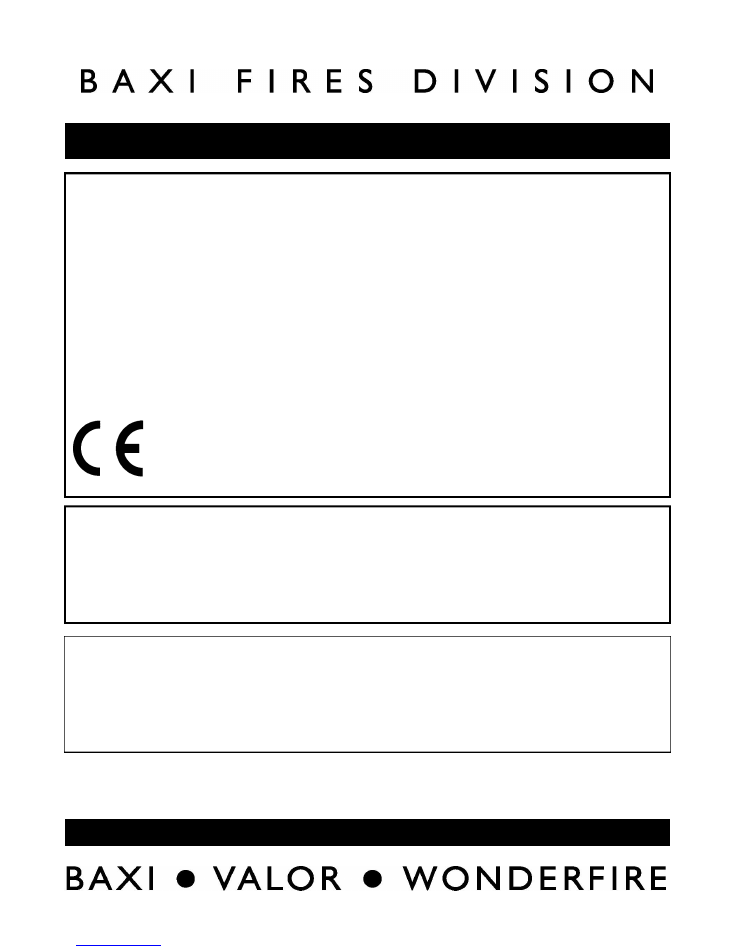
5112225/01
OWNER GUIDE
This guide is intended to help you care for your Baxi Fires Division gas fire. Please read
thoroughly before using and keep for future reference.
This guide to be left with the owner.
THIS APPLIANCE IS FOR USE WITH NATURAL GAS (G20).
WHEN CONVERTED USING CONVERSION KIT NO. 0595211 THIS APPLIANCE
IS FOR USE WITH PROPANE GAS (G31).
THIS APPLIANCE IS SUITABLE ONLY FOR INSTALLATION IN THE UNITED
KINGDOM (GB) AND THE REPUBLIC OF IRELAND (IE).
We trust that this guide gives sufficient details to enable your appliance to be operated
and maintained satisfactorily. However, if further information is required, our
Baxi Fires Division Technical Helpline
will be pleased to help.
Please telephone 08706 061 065
(National call rates apply in the United Kingdom). In
the Republic of Ireland telephone
0044 8706 061 065.
Model 741
INSET LIVE FUEL EFFECT GAS FIRE
Fitted with
Blenheim
or
Sonnet
fascia
(GC No. 32-032-56)
© Baxi Heating U.K. Ltd.
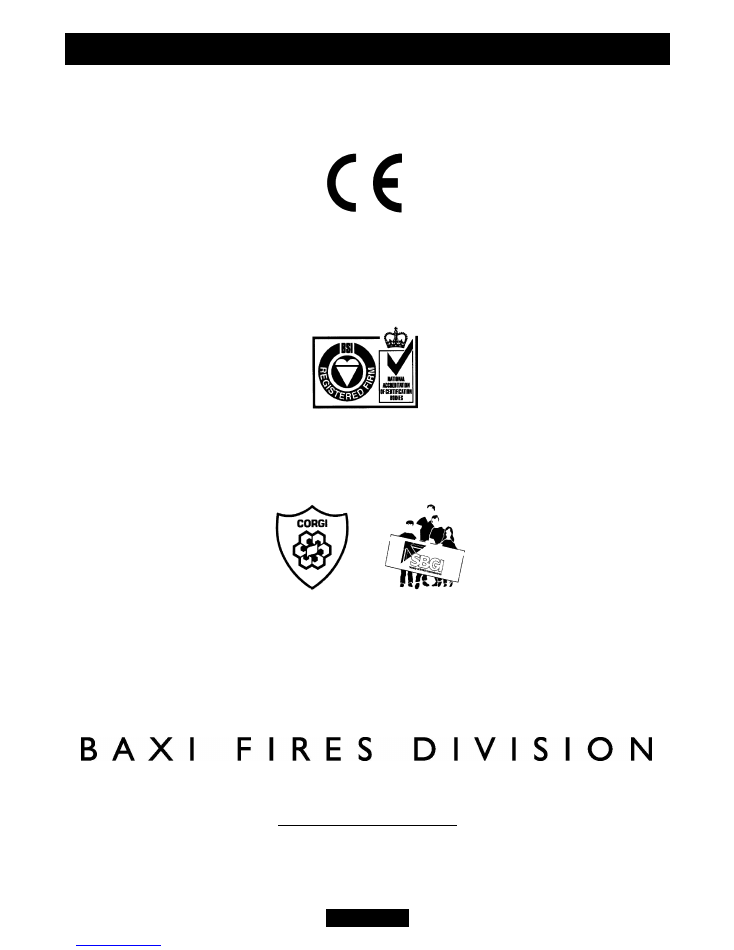
Safety First.
Baxi Fires Division fires are CE Approved and designed to meet the appropriate British
Standards and Safety Marks.
Quality and Excellence.
At the heart of every Baxi Fires Division fire.
All Baxi Fires Division fires are manufactured to the highest standards of quality and
excellence and are manufactured under a BS EN ISO 9001 quality system accepted by
the British Standards Institute.
The Highest Standards
Baxi Fires Division is a member of the Society of British Gas Industries which works to
ensure high standards of safety, quality and performance.
Careful Installation
Baxi Fires Division is a CORGI registered company. All our gas fires must be
installed by a competent CORGI Registered Installer in accordance
with our Installer Guide and should not be fitted directly on to a
carpet or floor of combustible material.
Baxi Fires Division, Erdington, Birmingham B24 9QP
www.firesandstoves.co.uk
Because our policy is one of constant development and improvement, details may vary slightly from those
given in this publication
Page 2
OWNER GUIDE

LIST OF CONTENTS
Section
Page
SAFETY
4
APPLIANCE DIMENSIONS
5
GAS CONSUMPTION
6
OPERATING YOUR FIRE
6
The Oxysafe flame sensing and flue blockage safety system.
6
To light the fire.
7
Lighting with a taper.
8
CLEANING YOUR FIRE
8
Metal Parts
8
Ceramic fuel effect pieces and burner compartment walls.
8
Burner.
9
CERAMIC FUEL EFFECT REFITTING
9
MAINTENANCE
12
Regular maintenance.
12
Servicing.
12
USEFUL TELEPHONE NUMBERS
12
This gas fire is designed to meet the most stringent quality, performance and safety
requirements to provide you with many years’ trouble-free service.
This guide aims to improve your understanding and appreciation of your gas fire by
providing simple and informative instructions to ensure that you benefit from the
excellent performance and features it has to offer.
Page 3
OWNER GUIDE
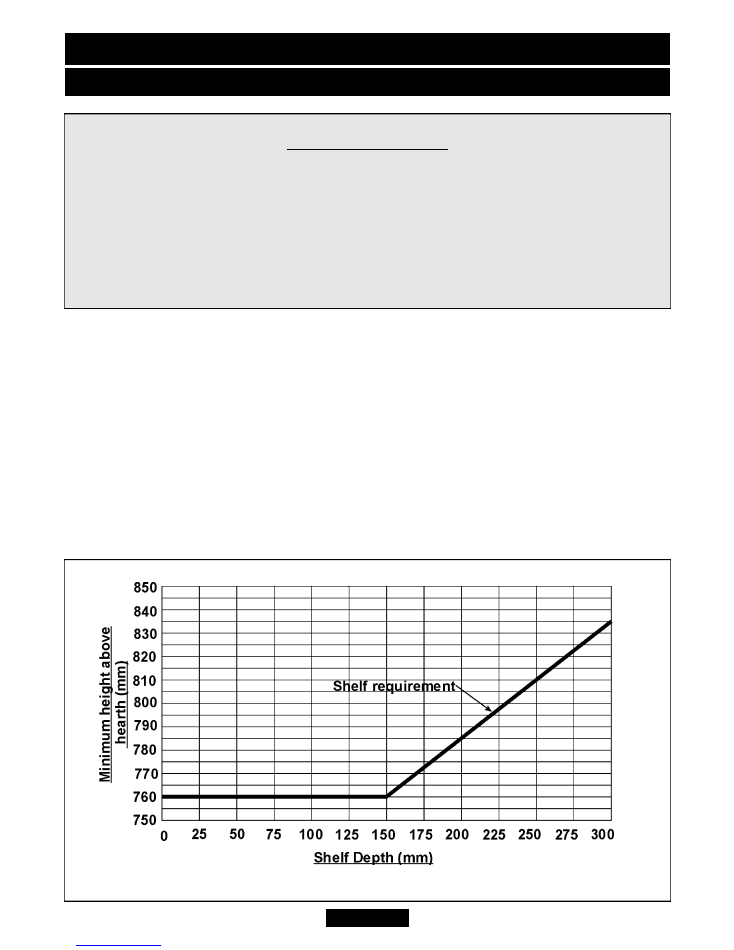
SAFETY
Do
have the fire installed by a competent person. In the United Kingdom, installation
must be in accordance with the latest edition of the Gas Safety (installation & use)
Regulations. In the Republic of Ireland, installation must be in accordance with all
national and local regulations in force.
Do
have the chimney swept prior to installation if it was previously used for solid fuel.
Do
have the fire installed in accordance with the installer guide.
Do
allow a minimum clearance of 760 mm from the top of the base of the hotbox to the
underside of any shelf whether it is made from combustible or non-combustible
materials. For a shelf made from wood or other combustible materials deeper than
150mm add 12.5mm to the clearance for every 25mm of additional shelf depth (See
graph 1). Please bear this in mind if ever you add a shelf.
Page 4
OWNER GUIDE
IF YOU SMELL GAS
DON’T SMOKE
EXTINGUISH ALL NAKED FLAMES
DON’T TURN ELECTRICAL SWITCHES ON OR OFF
TURN OFF THE GAS SUPPLY AT THE METER
OPEN DOORS AND WINDOWS TO GET RID OF THE GAS
IMMEDIATELY CALL THE GAS EMERGENCY SERVICE - SEE YOUR
LOCAL TELEPHONE DIRECTORY
Graph 1. Combustible shelf clearances.
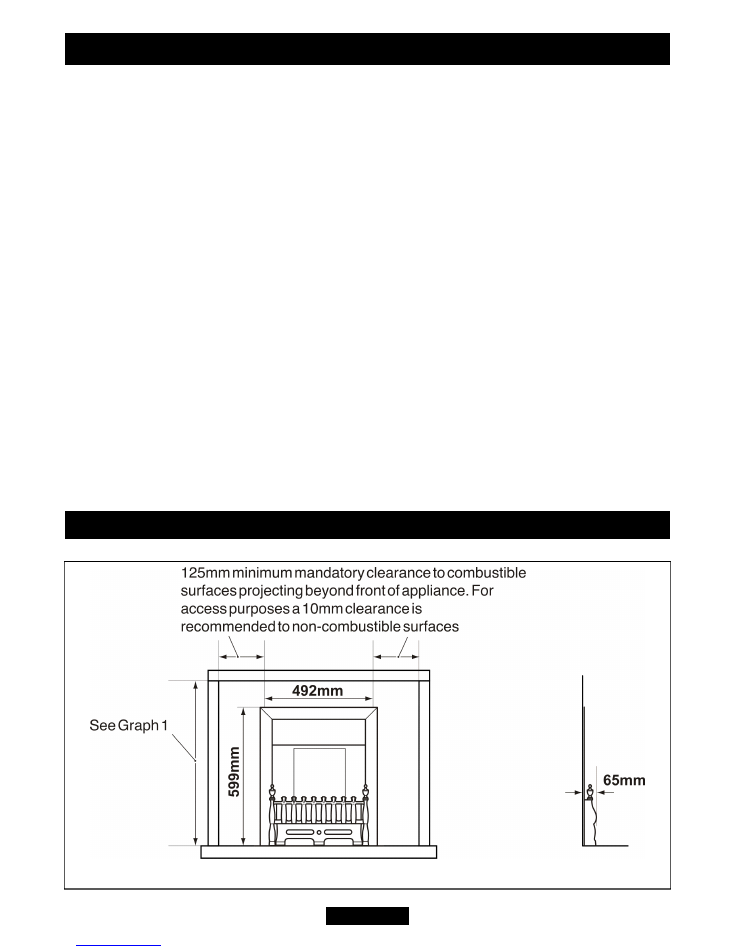
Do
provide a suitable guard that complies with BS 8423 for the protection of young
children, the elderly and the infirm. Such a guard is also recommended for the
protection of pet animals. (Although this fire conforms to all the applicable standards, it
is a heating appliance and certain parts of its surface will become hot).
Do
wait three minutes before attempting to relight if the fire is switched off or the
flames are extinguished for any reason. (Your fire is fitted with a safety device that will
automatically shut off the gas supply to the fire if, for any reason, the flames go out).
Do
get advice about the suitability of any wall covering near your fire. Soft wall
coverings (e.g. embossed vinyl, etc.) which have a raised pattern are easily affected by
heat. They may, therefore, scorch or become discoloured when close to a heating
appliance. Please bear this in mind whenever you are considering redecorating.
Do
provide a minimum side clearance as detailed in figure 1. Please bear this in mind if
ever you are considering altering the room.
Don’t
hang clothing, towels or any other fabrics over the fire.
Don’t
add any extra fuel effect pieces above the number stated in this guide. This could
cause a safety hazard.
Don’t
put paper or any other material on the fire.
Don’t
place any combustible material (rugs, carpet, plastic tiles, etc.) on the hearth.
Don’t
attempt to clean or service the fire until it has been switched off and allowed to
cool completely.
APPLIANCE DIMENSIONS
Page 5
OWNER GUIDE
Figure 1. Appliance dimensions

GAS CONSUMPTION
Model 741
Has a maximum natural gas input of 6.85kW (Gross)
Has a maximum natural gas output of 3.4kW
Has a minimum natural gas input of 2.3kW (Gross)
Has a minimum natural gas output of 0.09kW
Model 741 when converted using kit number
0595211
Has a maximum propane gas input of 6.7kW (Gross)
Has a maximum propane gas output of 3.71kW
Has a minimum propane gas input of 4.0kW (Gross)
Has a minimum propane gas output of 2.10kW
OPERATING YOUR FIRE
The Oxysafe flame sensing and flue blockage safety system.
For your safety, this appliance is fitted with a flue blockage safety device which will
shut down the appliance in the event of abnormal flue conditions.
This device is NOT a
substitute for an independently mounted Carbon Monoxide detector.
The device will also automatically shut off the gas supply to the fire if the pilot flame
goes out due to lack of oxygen or for any other reason.
If this device starts to repeatedly shut off the gas, get expert advice.
This device incorporates a probe which senses that the heat from the pilot flame is
correct. If this probe is cool, the device will prevent any gas flow unless the control
knob is held in at the ignition position.
If, for any reason, the flames go out when the fire is hot or if the fire is turned off when
hot, always
wait at least three minutes before attempting to relight
.
Page 6
OWNER GUIDE
PLEASE NOTE
When operating your fire for the first time, some vapours may be given off which may
cause a slight odour and could possibly set off any smoke alarms in the immediate
vicinity. These vapours are quite normal with new appliances. They are totally harmless
and will disappear after a few hours use.
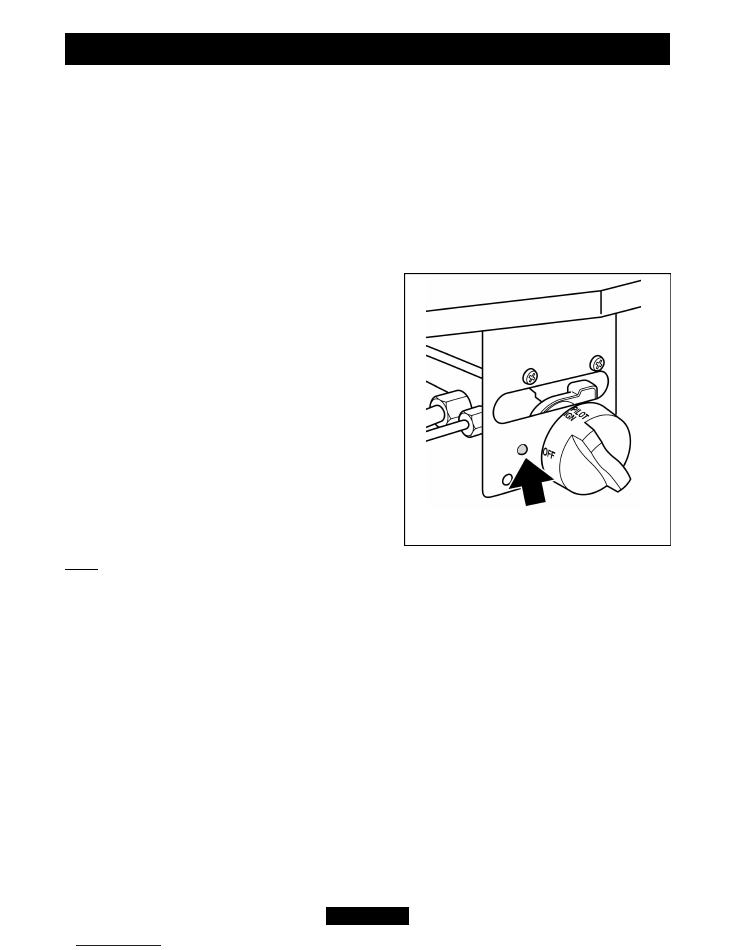
To light the fire.
Depress the control knob and rotate it anticlockwise to the pilot ignition position. A
'click' will be heard as the integral piezo operates. A flame should appear at the pilot.
Keep the control knob depressed and hold the pilot ignition position for five seconds.
When the control knob is released the pilot flame should remain lit. If a flame does not
appear at the pilot then turn the control knob clockwise to the 'OFF' position and repeat
the above.
When the pilot burner is operating properly, gradually turn the control knob anti-
clockwise to 'HIGH' position. (Depress the knob slightly to get past the pilot ignition
position). The main burner should now light.
Depress the control knob slightly to release from
the 'HIGH' position and turn back (clockwise) to
'LOW'. While turning, the burner flames should
gradually become lower but remain alight.
Depress the control knob slightly to release from
the 'LOW' position and turn back (clockwise) to
the Pilot ignition position. The main burner
should extinguish but the pilot should remain
alight. Depress the control knob slightly and turn
back (clockwise) to turn OFF. This will
extinguish the pilot.
While cooling, the ceramic fuel effects may
make some crackling noises. This is quite
normal.
Note i)
If the flames go out while setting the control, repeat the full lighting
procedure. If the flames repeatedly go out have the fire serviced.
ii)
Please note. When first turned on the flames will appear predominantly
blue. The fuel effect pieces will take time to warm up. Although some glow
will be seen after approximately ten minutes, the full visual effect will only
be apparent after a somewhat longer time.
iii)
The appliance will operate to its maximum potential if the flue is primed
during the first 20 – 30 minutes of operation. To do this, simply slide the
control button to its highest setting. This will also burn off any carbon
deposits that may have formed during previous operations.
iv)
If operating the appliance for long periods it is beneficial occasionally to
change the settings. This will also help to remove any carbon deposits that
may form during operation.
Page 7
OWNER GUIDE
Figure 2. The Control
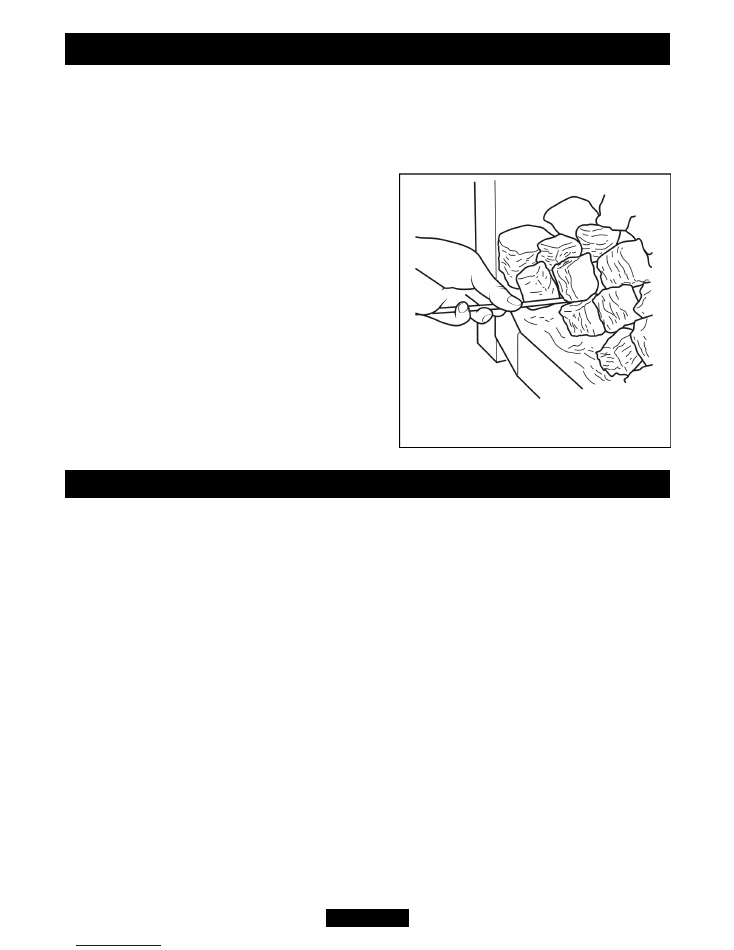
Lighting with a taper.
(See figure 3).
In the unlikely event of failure of the ignition spark, the pilot can be lit by a taper or
long spill.
!
Turn the control knob to the 'Pilot ignition' position
!
Insert the taper or spill between the second
and third left hand ceramic fuel effect pieces on
the first row
!
Depress the control knob. A flame should
appear at the pilot.
!
Remove the taper and keep the control
depressed for 5 seconds.
!
Release the control knob and the pilot flame
should remain alight. If it does not, repeat the
above.
!
Turn the control knob to the required setting.
While cooling, the ceramic fuel effect pieces
may make some crackling noises. This is quite
normal.
CLEANING YOUR FIRE
To maintain the high performance and quality finish of your fire please follow these
guidelines:
Before attempting to clean the fire, please remember to turn off the fire and wait for the
appliance to cool. The fire will retain heat for some time before cleaning can begin.
If any pieces of debris are found in the firebox, have the chimney inspected before
further use.
Metal Parts
!
Clean the metal parts with a slightly damp cloth and then dry.
!
Do not use abrasive cleaners as these will scratch the fire surface.
Ceramic fuel effect pieces and burner compartment walls.
This product uses fuel effect pieces and burner compartment walls containing
Refractory Ceramic Fibres (RCF), which are man-made vitreous silicate fibres.
Excessive exposure to this material may cause irritation to eyes, skin and
respiratory tract. Consequently, it is important to take care when handling these
articles to ensure that the release of dust is kept to a minimum.
!
Light coatings of soot will usually be burnt off during the normal operation of the
fire. Should any soot accumulation become excessive, the fuel effect pieces and walls
Page 8
OWNER GUIDE
Figure 3. Lighting with a taper
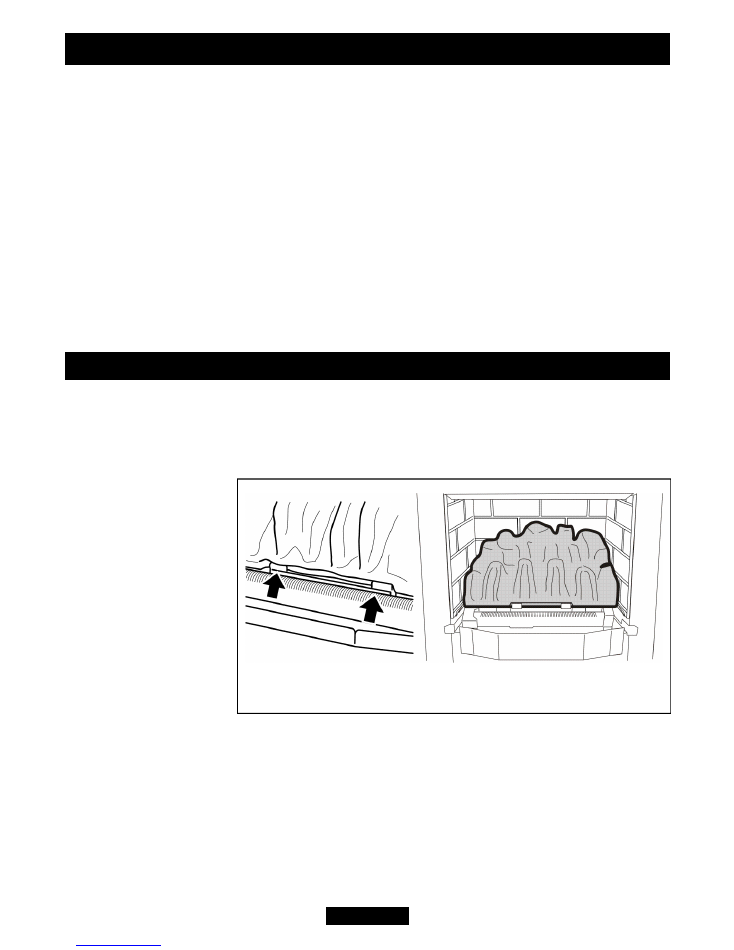
should be removed from the fire for cleaning.
!
Cleaning should be carried out in a well ventilated area or in the open air by gently
brushing with the pieces held away from your face so that you avoid inhaling the dust.
!
We do not recommend the use of a normal domestic vacuum cleaner which may
blow dust back into the air.
!
We suggest that you remove the ceramic fuel effect pieces in the reverse order to
that shown in this guide.
Burner.
Remove any deposits of soot or other foreign matter from the surface of the burner with
a dry soft brush. Be careful not to brush any particles into the open slots. Remove any
particles from the slots with a vacuum cleaner fitted with a soft brush attachment.
Do
not poke wire, etc. into the slots in the burner.
CERAMIC FUEL EFFECT REFITTING
1.
Place the ceramic base coal in the burner compartment. The bottom rear face of the
coal should rest on the angled ledges at the back of the burner compartment. The bottom
front recess edges on the coal base should locate against the tags at the front of the
ceramic support (See figure 4).
Page 9
OWNER GUIDE
Figure 4. Ceramic base location
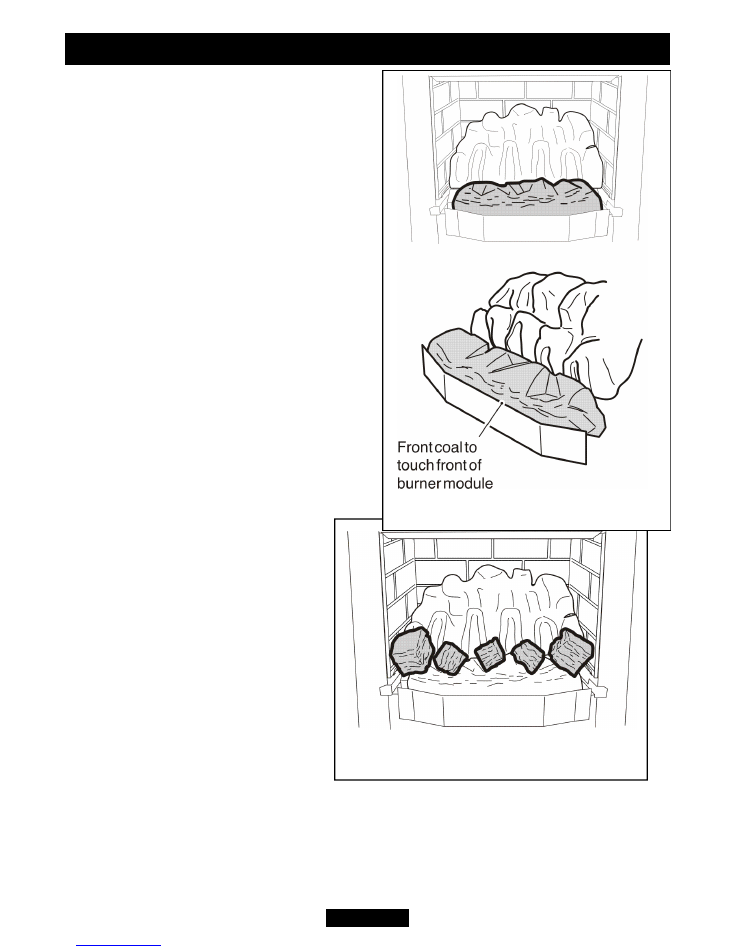
2.
Place the ceramic front coal in position in
front of the base coal. The front of the
ceramic coal should touch the front of the
burner module (See figure 5).
The loose ceramic coals are supplied in three
sizes. There are two large ceramic coals, three
medium ceramic coals and 12 small ceramic
coals. When installing the ceramic coals
smooth surfaces should be positioned to the
bottom or rear unless stated otherwise. Install
the loose coals as follows.
3.
Locate the two large ceramic coals at the
ends of the front base ceramic coal. The large
ceramic coals have two sides that are smooth.
Locate one smooth side along the side of the
hotbox and the other to the rear (See figure
6).
4.
The top surface of the front ceramic base
coal has three ‘V’ shaped indents.
Locate a small ceramic coal into each indent
(See figure 6).
Page 10
OWNER GUIDE
Figure 6. First row of ceramic coals
Figure 5. Front coal location
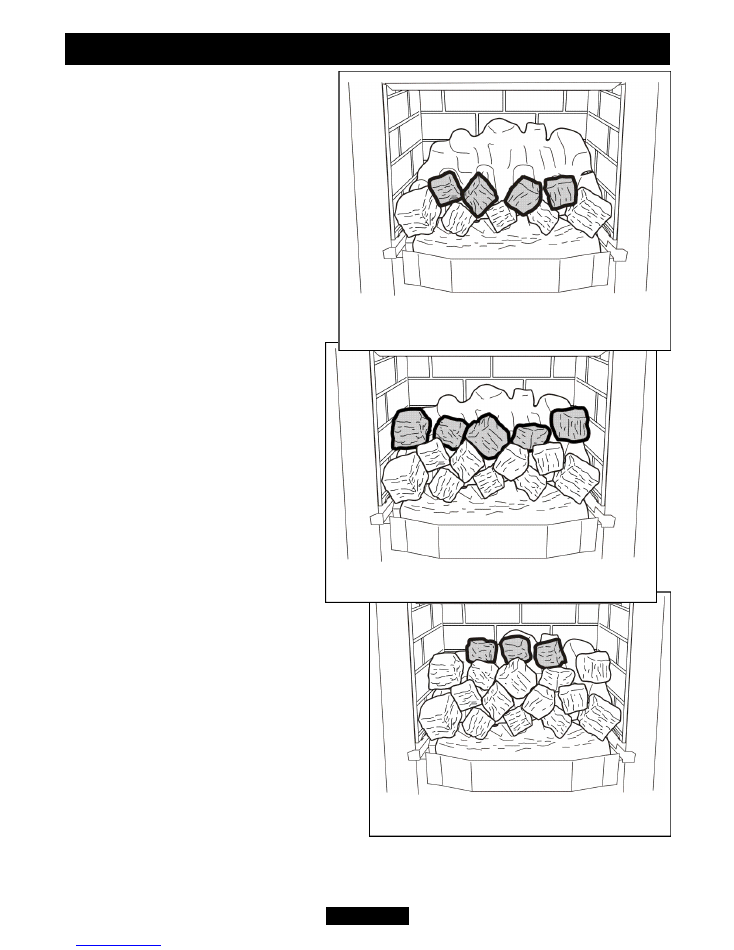
5.
Locate four small ceramic coals into
the spaces on top of the first row of
ceramic coals (See figure 7).
6.
Place a medium ceramic coal into
the central valley in the rear ceramic
base. It is important that this medium
ceramic coal has a space behind it.
Place a small ceramic coal each side of
the medium ceramic coal. It is
important that these small ceramic
coals have a space behind them. (See
figure 8).
7.
Locate the remaining medium
ceramic coals in the valley behind the
two large ceramic coals on the front
row (See figure 8).
8.
Locate a small ceramic coal behind
the central medium ceramic coal.
This should be held in place between
the medium ceramic coal and the
ceramic base coal (See figure 9).
Locate the remaining small ceramic
coals each side of that located
previously. These should sit behind
and be held in place by the small
ceramic coals in front.
Page 11
OWNER GUIDE
Figure 9. Fourth row of ceramic coals
Figure 8. Third row of ceramic coals
Figure 7. Second row of ceramic coals

MAINTENANCE
Regular maintenance.
In order to achieve and maintain high levels of personal safety and performance
efficiency, it is essential that the opening at the back of the fire and the flue are kept
clear of any form of obstruction. It is possible that deposits of mortar or soot could fall
and accumulate causing the flue to be blocked or restricted and so preventing proper
clearance of dangerous exhaust fumes.
In the United Kingdom it is the law that a landlord must have any gas appliance, flue
and pipework which is situated in a tenant’s premises checked for safety at least every
twelve months by a competent person (In the U.K, a CORGI registered installer).
We recommend that all gas appliances and their flues, wherever situated, are checked
annually.
Servicing.
Servicing can be carried out either by a Baxi Fires Division Service engineer or a
CORGI registered installer. If you require your fire to be serviced, please contact
Baxi
Fires Division Service
on
08706 090 081
and quote the following details. These can be
found on a plate located below the burner and behind the lower front cover.
Type of fire.
Model/Name.
Serial Number.
You will also be asked for the fault, problem or request plus your Post Code.
USEFUL TELEPHONE NUMBERS
General advice about gas and your gas fire:
BAXI FIRES DIVISION TECHNICAL HELPLINE 08706 061 065.
To report faults or arrange for your fire to be serviced:
BAXI FIRES DIVISION SERVICE 08706 090 081.
F
or sales or product information:
BAXI FIRES DIVISION SALES 08706 061 067.
To order spares
Spare parts are available nationwide via the ‘interpart stockist network’. For your
local stockist consult Yellow pages under ‘Central Heating’.
CALLERS IN THE REPUBLIC OF IRELAND
Call
0044 8706 061 065
Page 12
OWNER GUIDE